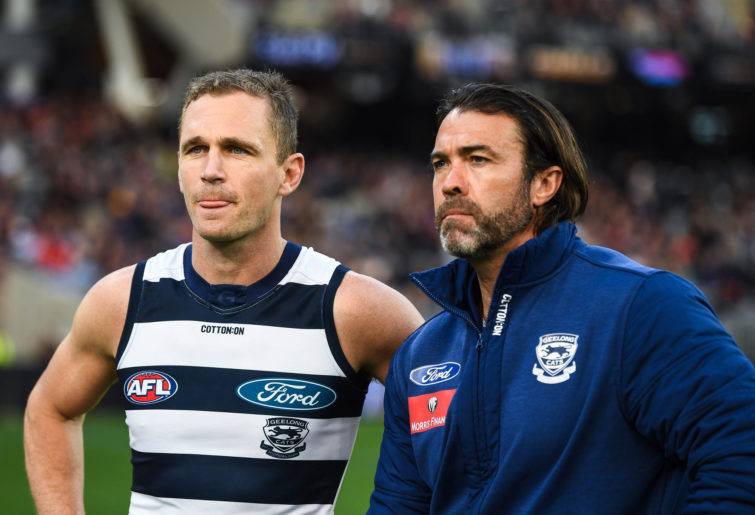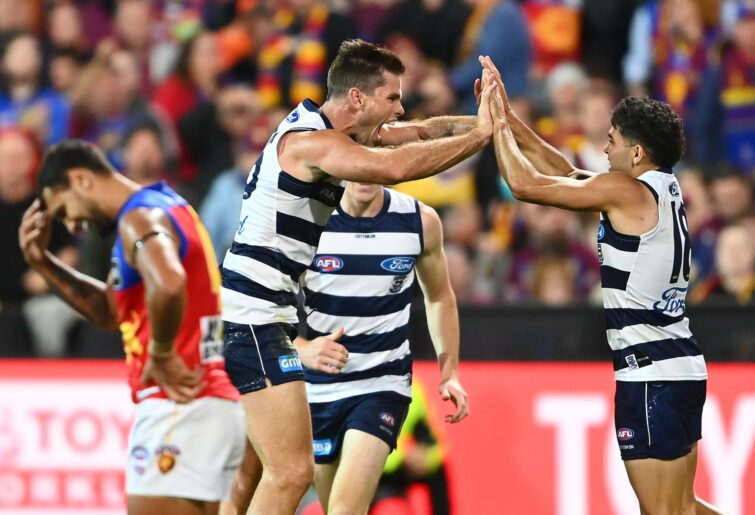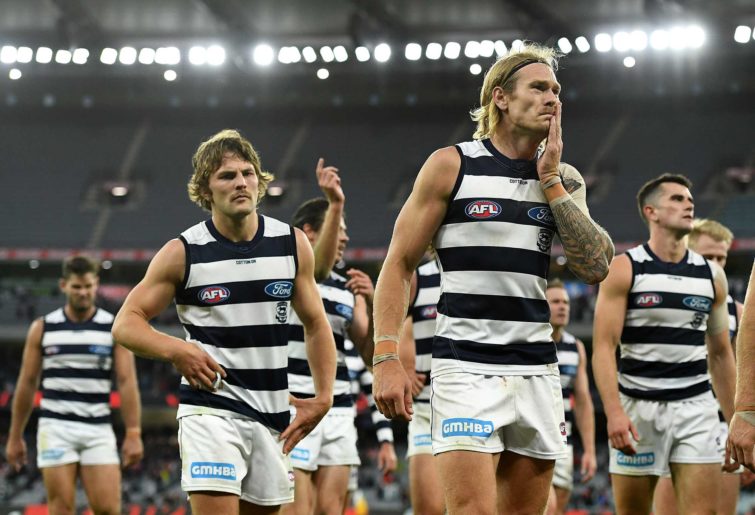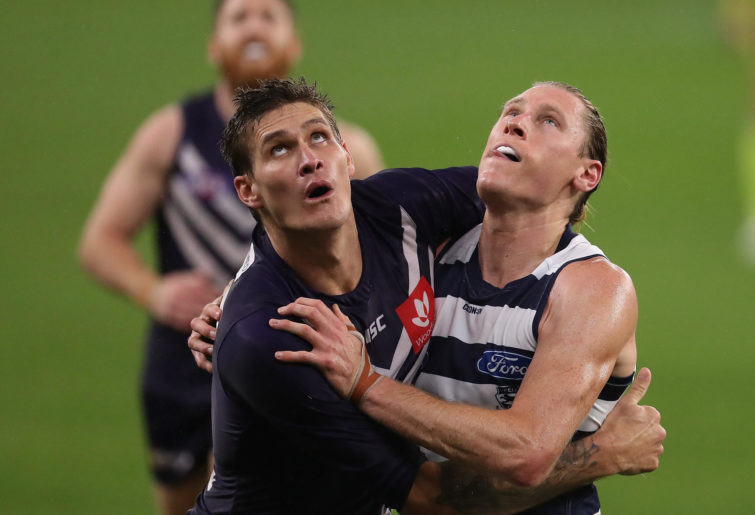Geelong are playing the sort of football that makes the team super dangerous going forward.
For years, the majority of us have mocked the Cats for being too old and too slow.
Despite missing the finals just once since 2006 and tallying seven top-four finishes in the last nine seasons, the Cats have only made the grand final once during that time and more concerningly have conceded more points than they’ve scored in all but one finals series.
There are two sides to this piece of history.
Clearly, it’s incredible how relevant this club has stayed for such a long period and fans are justifiably proud and content with repeated finals appearances, holding similar stature in the game to the NBA’s San Antonio Spurs.
Non-Geelong supporters have been publicly critical of a team seemingly desperate to cling onto false hope, repeatedly topping up with experience to keep their window open for as long as possible.
The reality is that both points of view probably have some validity. The longer the Cats continue to be the league’s oldest team, the criticisms grow louder and louder.
After seven rounds in 2022, the Cats are sitting 4-3 and continue to face their detractors.
2022, though, is giving us a different version of Geelong – one that was desperately required.
If Chris Scott was going to continue persisting with this playing group, he had to buck the recent trend of defined insanity and make tactical adjustments.

(Photo by Daniel Carson/AFL Photos via Getty Images)
He has, and he must be commended, because the Cats are playing completely different footy to what they’ve produced in recent history, which has only taken them to one grand final and more often than not an overwhelmingly poor finals exit.
If you continue to criticise Geelong’s age profile, then you must acknowledge the fact that Scott has adjusted his team to keep an eye on the future.
Sam De Koning is 21 years of age and isn’t playing a peripheral role like how some other clubs opt to use their young players. He’s the club’s fullback and main key defender, and the one they trust the most in one-on-ones.
Brandan Parfitt at 24 is one of the team’s main midfield movers and is having a career-best season with more stoppage attendances.
Brad Close and Tyson Stengle, both 23, have taken over as the dominant, impactful small forwards who push up the ground.
Max Holmes (19) has played a wing role and Jack Henry is still 23.
This isn’t a list of young players written for the sake of it – these are the Cats of the future that Chris Scott has consciously placed into significant structural roles to have a meaningful impact on their development.
Yes, there’s a reliance on veterans, but 2022 is chalk and cheese compared to even last season, when fans screaming for youth would only be appeased on occasion in largely peripheral roles.
This is only one part of the significant change undertaken by Scott to re-energise his playing group and play out a meaningful season.
Instead of defence-oriented, patient football, the Cats are now playing an extremely attacking style.
In fact, the defence has suffered significantly in this focus shift, but it’s perhaps the best sign of things to come.
It’s not as simplistic at looking the ladder, although the average of 95.14 points for and 80.29 points against are the highest they’ve been since 2017.

(Photo by Quinn Rooney/Getty Images)
Rather than chip the ball around and try to stretch the opposition, Scott has been teaching the group to speed up their ball movement and go direct.
Even as recently as pre-Round 7, captain Joel Selwood acknowledged that the playing group was still adjusting to the new demands being asked of them.
The numbers are uncharacteristic and refreshing.
After seven rounds, Geelong are averaging 57.7 inside 50s per game, the most since 2011 and up from 50.4 last season.
Matching such highs, the Cats are averaging just 6.37 disposals per inside 50, down from 7.28 in 2021 and again, it is their best ratio since their last flag. This is among the best in the league.
It’s such a significant change to the style that it’s understandable why some veterans are taking time to adjust.
But clearly, it is benefitting the forwards greatly, averaging 16.1 marks inside 50, which would be an AFL record if it were to continue.
When Geelong win the ball, they’re clearly avoiding lateral ball retention where possible, as they feel the current trend of quick movement maximises the firepower the team owns up front with two of the league’s best key forwards.
The Cats are averaging 5890.9 metres gained, ranked fifth in the league. It’s a number that without context is difficult to follow, but since the statistic was first monitored in 2014, Geelong have never covered this much ground with the ball.
Marks are down to 86 per game from 97.6, which matches the new philosophy and is the lowest we’ve seen from the team in modern history, matching up well with the increase in metres gained.

(Photo by Dylan Burns/AFL Photos via Getty Images)
The offensive ball movement is designed to be swift and destructive and it’s done at almost all costs. The Cats were dominant in the first quarter against Fremantle in Round 7, but when the forward pressure of the opposition ramped up, the home team’s ball movement was stifled.
They didn’t look like scoring for a good half hour but when they entered their forward half, the Cats were still efficient.
Defensively, there have been clear issues, but fans shouldn’t be distraught with the defensive season thus far.
The tackling is excellent, ranked fourth in the league so far after being ranked 12th last season. The average of 72 intercepts per game is a clear club record and is largely due to the pressure applied.
A by-product of the new attacking style of play has been the reduction in help defence on offer.
Geelong’s key defenders are being exposed to more one-on-ones than previous seasons – De Koning and Henry have defended 3.8 per game, with the former rated above average and the latter’s numbers suffering from a shocker against Brisbane.
They’re being scored against quite easily – opposition clubs are kicking goals with 25.26 per cent of their inside 50s, up from 21.21 per cent in 2021.
The Cats are conceding easier shots on goal than previously, largely due to the offensive commitment of the team. There are more goals out the back and there is more space inside 50.

(Photo by Quinn Rooney/Getty Images)
It is slightly misleading, however, with the Cats’ opponents clearly being the most accurate in the league and Champion Data indicating Geelong have been six to seven goals worse off than expected.
The commitment to attacking has resulted in the team welcoming more pressure generally. They’re conceding 50 more disposals than last season and their opponents are ranked seventh and sixth for disposal efficiency and tackles inside 50s respectively, which were previously bottom-four statistics.
Why, then, should Cats fans not be worried by these clearly concerning trends?
Put simply, it seems like everything that is happening at Geelong, good and bad, is by design.
The best teams have always had multiple gears and multiple styles. In recent seasons, the Cats have been a truly excellent home-and-away team, but have been disappointing in finals looking to play in the same manner.
Right now, Geelong are developing an attacking style that is ultimately adding another string to their bow.
The defensive numbers have regressed significantly, but with purpose.
We’ve seen Tom Stewart playing a lot more on the wing than before and Mark Blicavs is playing higher up the ground than we’ve seen for a while, despite Rhys Stanley enjoying a career-best season in the ruck.
Jack Henry has seen his defensive responsibilities skyrocket at the expense of Jake Kolodjashnij, despite their roles being better suited to switching.
And the reason for this?
The Cats know how to defend and have mastered their defensive schemes over a period of years.

(Photo by Paul Kane/Getty Images)
They can always revert back to what they know is largely effective and among the league’s best in terms of defensive efficiency, but there’s no need to while the offensive game plan is developing.
In 2019, Richmond were 7-6. All their losses were by at least 33 points, with four of them by at least seven goals.
During those 13 games, they averaged 77.69 points, suffering from inaccuracy and conceded 84.46 points per game.
They didn’t lose after that point, averaging 99.42 points, and conceding just 60.17.
Damien Hardwick trialled different tactics during the first half of the season before combining them with what Richmond already knew, ultimately keeping his cards close to his chest.
For years, it has felt like the Cats had only one way to pay and that Chris Scott had no other cards to play.
This season is different. We’ve seen the Cats play differently, we’ve heard their captain acknowledge it and we have seen the numbers.
Geelong have figured out a way to improve the way they play without giving much away to the opposition.
If you’re a supporter of the club, you should remain excited, even if the Cats head into their bye on the fringes of the top eight at worst.
For the first time in years, it feels like there’s purpose and long-term control to the Cats.
Write them off at your peril, because the 2022 version of Geelong is the most dangerous the Cats have been for a while.

































































































